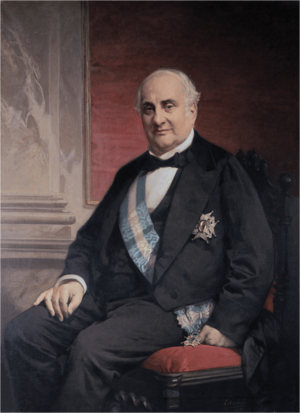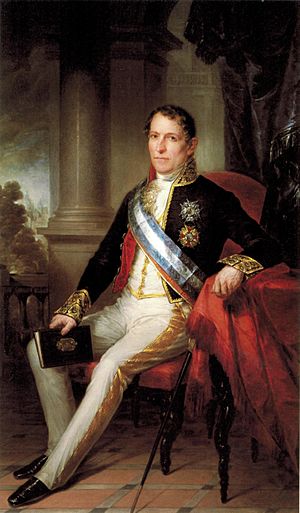Spanish tax reform of 1845 facts for kids

The Spanish tax reform of 1845 was a big change to how taxes were collected in Spain. It was approved in 1844 and set up a new system that is still partly used today. This reform made the tax system simpler and fairer for everyone.
Contents
Why Spain Needed Tax Changes
In 1843, there was a change in the Spanish government. A group of generals from the Moderate Party, including Ramón María Narváez, took power. They replaced the previous leader, Baldomero Espartero, who had been acting as a "regent." A regent is someone who rules a country when the king or queen is too young.
At this time, Queen Isabella II was only 13 years old. But after the government change, she was declared old enough to rule on her own. This started a ten-year period called the década moderada, where the Moderate Party was in charge.
How the Tax System Changed

The new government, led by Ramón María Narváez, decided to fix Spain's tax system. A smart person named Ramón de Santillán helped design the new plan. The Finance Minister, Alejandro Mon, was in charge of putting these changes into action.
Before this reform, Spain had a very old and complicated tax system. Different parts of the country, like the old Kingdom of Aragón and Navarre, had their own tax rules. Many of these taxes had been around since the Middle Ages.
The 1845 reform aimed to make the tax system more modern and fair. It followed ideas of economic liberalism, which means making rules that help the economy grow. The new system wanted:
- Fairness: Taxes should apply to everyone.
- Enough Money: The government should collect enough money.
- Clear Rules: The tax system should be easy to understand.
One big change was getting rid of internal customs barriers. These were like taxes on goods moving between different regions within Spain. Old taxes like the diezmos (a tax for the church) and alcabala (a sales tax) were also removed.
The reform shifted from mostly indirect taxation to more direct taxation.
- Indirect taxes are paid when you buy goods or services (like sales tax).
- Direct taxes are paid straight from your income or property.
The new system introduced five main types of taxes:
- Direct Taxes
- A tax on real property (land and buildings), farm crops, and livestock (animals). This was expected to bring in about 25% of the government's money.
- A tax on industry and trade, which had two parts: one that changed based on how much was produced, and one that was a fixed amount.
- A temporary tax on renting property, which only lasted for one year.
- Indirect Taxes
- Consumption taxes on certain goods like alcoholic beverages, olive oil, soap, and meat.
- Government monopolies on goods like snuff (a type of tobacco), salt, and lotteries. This meant only the government could sell these items.
- A tax on mortgages, which applied when property was transferred, rented, or when rents increased.
The reform also changed the fees for goods coming into or leaving the country (called tariffs).
What Happened After the Reform
The new tax on industry and trade caused many protests and led to a lot of fraud (people trying to avoid paying taxes). The Spanish government wasn't fully ready to collect these new taxes. So, they often let local governments and guilds (groups of people in the same trade) collect the taxes for them.
The consumption taxes were also unpopular. Many people felt they unfairly affected poorer people more than rich people.
Despite these challenges, the 1845 tax reform helped Spain's finances get back on track during Queen Isabella's rule. It also allowed the government to start new public works projects, like building roads. The system stayed mostly the same until 1900. After Spain lost its colonies in the Spanish–American War, another tax reform was needed, led by Raimundo Fernández Villaverde.
Images for kids
-
Alejandro Mon, Finance Minister of Spain in 1845.
-
Ramón de Santillán was one of the key figures who drove the tax reform of 1845.
See also
 In Spanish: Reforma tributaria de 1845 para niños
In Spanish: Reforma tributaria de 1845 para niños



